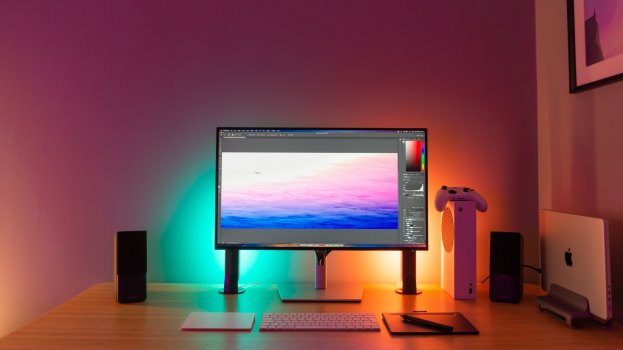I also went from a 5K iMac to a 4K 27" Dell P2715Q monitor. At normal distance, I could not tell the difference at 2560x1440. Up close, yes, I could see the resolution difference. That was back in 2018.I sit here with an LG 21.5" 4k display, very high DPI next to a 27" 4k display. I am very much a fan of retina displays and appreciate the added sharpness as I work with text all day. I tend to follow general ergonomic recommendations and do not push my monitor very far back from where I sit (it's bad for eye strain). I configure the 27" 4k display to "appear like 2560x1440".
So basically what I'm saying is, if the 4k 27" class of display was substantially worse than the 5k 27" class, it would be easily visible to me either due to looking at a much higher res. display and seeing the direct comparison constantly or simple seeing it because it's only about 18" away from me.
I have no issues with this 4k display. If I inspect closely then yes, I can see slightly more jagged edges and such than the higher DPI display next to it. But in practical sitting positions it looks like a retina display.
I can't speak to the quality of the Dell under discussion specifically, but, at least the 27" 4k version should look just fine in the larger context of high resolution displays. It's still a relatively high DPI.
My experience with Dell displays in general has been overwhelmingly positive. They are some of the most reliable displays I've ever used and I've used many brands. The second monitor I mentioned is an LG, amongst several I've owned and a few more I've researched I can find one consistency: they all have stupid functional problems that are inexcusable for their price point. For example, while my 22" LG looks amazing in sharpness terms, its backlight is so intensely blue shifted that accurate color is impossible no matter what I do for calibration. It has a faint but annoying buzz that emits from the back when it's not on. It frequently just doesn't turn on when the computer wakes up, something I was able to reproduce with a Windows machine so it's not just some macOS bug.
Continuing on with LG issues, I also have the infamous LG 5k2k ultrawide (34WK95U-W) and that display... it should've been amazing, but, instead it had random issues waking up on Thunderbolt forcing a fully power cycle and the worst burn-in I've seen on any computer display in 20 years. The LG 5k has similar known issues.
If I was only choosing between the LG 5k and this Dell, it would be no contest. I would choose the Dell. There is more to a display than the panel tech, so despite often using LG panels, the only 27" 5k displays that have ever been good have been those that come straight from Apple (or possibly some of the obscure or expensive 5k displays most people have never heard of or tried and aren't really for sale anymore anyway from Dell and whatnot targeted at the color sensitive "pro office" crowd a few years back).
So bottom line, I couldn't assure you the Dell is great because I haven't seen it, but, I can assure you that it's a mistake to buy the LG monitor. Or any LG monitor for that matter.
Right now I upgraded the P2715Q to a 32" Dell U3223QE. I pushed the monitor further away, and guess what, I do not see the pixels. But the upgrade is clear - better contrast and larger display, so the 2560x1440 looks bigger to my aging eyes with presbyopia.
I also have the opinion that Dell makes one of the most reliable displays. I have 4 displays that are 12 years old. And my employer (a large multinational with over 160K employees) uses only Dell monitors.



